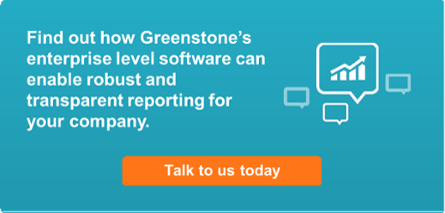'Bridging the materiality gap' – event summary
 Last week, Greenstone held a breakfast event in London on materiality reporting in partnership with Deloitte and Lodestar. The following article was written by Lodestar's Gail Boucher and gives a useful summary of the session and the topics discussed.
Last week, Greenstone held a breakfast event in London on materiality reporting in partnership with Deloitte and Lodestar. The following article was written by Lodestar's Gail Boucher and gives a useful summary of the session and the topics discussed.
It was great discussing the various aspects (ha ha) of materiality at the Bridging the Materiality Gap breakfast event on 27th January. It was hosted by Deloitte in conjunction with Lodestar, GRI and Greenstone, with guest speaker from URENCO.
Mike Barber, Partner from Deloitte introduced the morning and provided an introduction to materiality which provided a basis from which the presentations developed. We then heard about the essential elements of a materiality process, with the official take from Nikki McKean-Wood from GRI. It is helpful to hear once again how GRI recommends completing materiality as well as the new things that are coming out of GRI – like revised Sector Disclosures, reaching for further collaboration from Organisational Stakeholders and industry groups and the review of some sections of the guidelines.
I followed Nikki with some practicalities on materiality. I am always happy to discuss how an organisation approaches materiality – and that when compiling the materiality matrix, it should be used as a discussion point – and not necessarily be published – as the dots can move around. But it’s not the dots that are important, it’s where the threshold is drawn and the general awareness that an aspect is high on the list for stakeholder’s assessments and the associated economic, environmental or social impact. The matrix should be reviewed by senior decisions makers and discussed, which results in a list of the most material aspects for the current year.
There was much discussion around the large variances in Sustainability Reports on how they title the Y- and X-axis of the materiality matrix. GRI recommends, and it was reiterated by Nikki, that the Y-axis should be the ‘Substantive Influence of Stakeholders Assessment and Decisions’ and the X-axis should be the ‘Significance of Economic, Environmental and Social Impacts’. So many organisations take the X-axis as Impact on Business Success – which seems to be setting the organisation up against its stakeholders rather than on how severe the aspect impact could be. In so doing, during the senior decision making review, their judgment may be skewed without relevance to the significance of impact.Thereby possibly omitting something with a severe economic, environmental or social impact, but having little impact on business success. An example can vary widely amongst industries, but one that could have little direct impact on business success in the short term could be ‘community investment’ – however the impact could be dramatic if it affects an organisation’s license to operate due to community discontent. Enough said, just take note and care when using the materiality matrix, and perhaps consider using it as an internal discussion point and just produce a list of the organisation’s most significant aspects.
The last thing (in this instance!) from my perspective on materiality is that it isfluid, not set in stone and will change over time. Stakeholder’s views will change over time, impacts will change and all these considerations need to be reviewed on an annual basis. In addition organisations need to be listening to the stakeholders who might come up with the new aspects that should be on their radar.
David Wynn from Greenstone provided useful insight into the importance of data, rigorous collection and managing it. It was most interesting to note how data without stories are not very interesting and stories without data don’t really help the person who reads the report understand where the organisation is heading on their journey. I provide the series of statements that David presented so that you really understand how “data + stories” really makes sense.
“We reduced our emissions by 10%.”
“We reduced our Scope 3 emissions by 10%.”
“We reduced our Scope 3 emissions by 10% compared to 2010.”
“We reduced our Scope 3 emissions per employee by 10% compared to 2010 despite growth.”
“We reduced our Scope 3 emissions per employee by 10% compared to 2010 despite a FTE growth of 20%.”
“We reduced our Scope 3 emissions per employee by 10% compared to 2010 despite a FTE growth of 15%. By installing videoconferencing facilities in our New York and London offices we have been able to reduce the absolute number of international flights per month by 6%.”
I thought that this was an enlightening interpretation of how to represent and position the data. We were then provided with a very practical example by guest speaker, Alistair Dale from URENCO, on their sustainability journey. Ali covered how they have approached materiality, the challenges to the collection of the necessary data to complete the process for internal management and sustainability reporting.
Ali noted that in collaboration with Lodestar they had conducted a materiality assessment that determines ‘what matters, where it matters’ – the mantra from GRI. He highlighted that Lodestar helped URENCO transition from GRI G3 reporting to G4 reporting. We are always happy to assist clients with their materiality and reporting processes!
Currently URENCO is collecting data through the use of an excel spreadsheet. He discussed the challenges associated with the data collection and emphasised the need for executive support, maintaining knowledge and involvement from those in the organisation and trying to make sense of the different standards of measurements around the world. Ali did note what is next for URENCO, which is the understanding there is always an opportunity to improve on processes – whether that be through training, audits, company direction, further regulatory requirements and finally a review of software options to support better data collection.
Ali highlighted that in their investigation of software options, items to consider are:
- Efficiency vs. implementation cost
- Automated data checks
- Site approval
- Audit trail
- Reduced external audit costs
I thought the insight from URENCO wrapped up the morning nicely as Ali really tied in all the pieces of ‘Bridging the Materiality Gap’ into one real life experience. His presentation was followed by a question and answer session that clarified some of the items from the morning. All in all it was an informative morning, and I have received some good feedback from some delegates. I look forward to working with all participants again and hope to attend some more interesting sessions in the near future!
If you would like to get in touch, you may email me on gailb@lodestaruk.com or call the office at 0203 772 8995. Thanks and happy materiality! Gail Boucher.
To view the original article, please visit LinkedIn.










